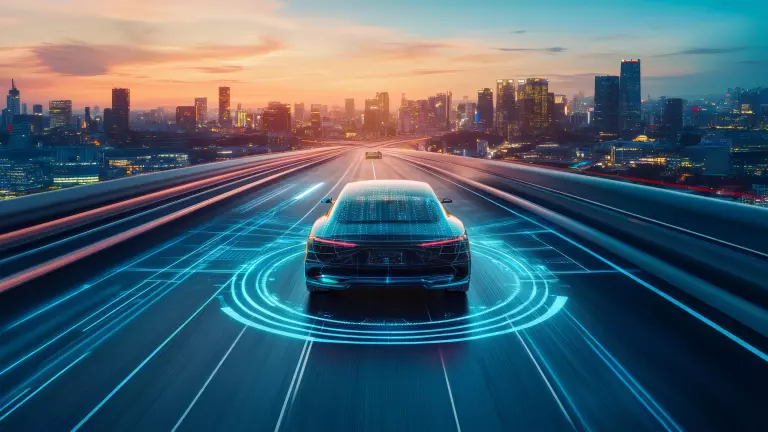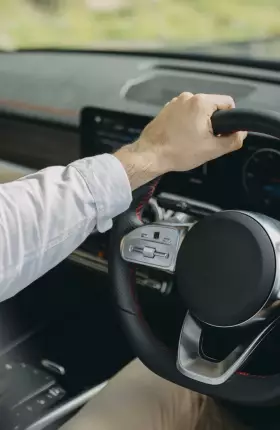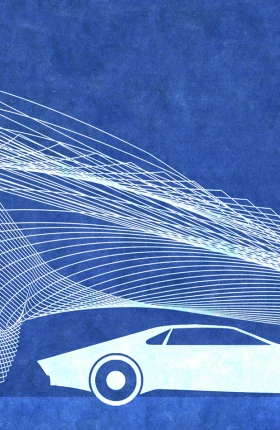Tier one auto suppliers are finding themselves caught in a squeeze. As the industry moves toward software-defined vehicles (SDVs), a new tech stack is taking shape. OEMs are already expanding down from the stack’s top layers (each of which represents its own market), while tier two suppliers are moving up. Tech players and others from outside the auto industry are moving in. Tier one suppliers that are still trying to determine where to play—and establish the necessary capabilities—risk being crowded out.
As SDVs gain greater traction, we expect the automotive software and electronics market to quadruple from today’s $320 billion to $1.2 trillion by 2035. Some 60% of this market is available to suppliers—software and electronics will represent 25% of their business in 2035—creating a potential strategic turning point and an enormous opportunity for traditional players. But to take advantage, suppliers need to align their business models, strategies, and capabilities with the demands of their OEM customers. New BCG industry research reveals that right now, there are major gaps between OEMs and their top suppliers, with each seeing very different priorities for the evolving role of tier one companies. Suppliers’ current offerings are farthest from meeting the needs of OEMs in the seven areas most important to automakers.
The industry is in flux, scale is necessary to compete in all layers of the SDV stack, and fragmented sources of supply are unlikely to work out. Top-tier suppliers have choices on how to position themselves, but each involves tradeoffs in terms of profitability and complexity. Some tech stack layers, for example, such as computing platforms, have already attracted large technology hardware players. Tier one suppliers need to switch gears fast, determine their ability to win at the various layers of the stack, and choose their path to scale quickly as the new market takes shape.
The Developing SDV Market
As the overall SDV market quadruples over the next decade, the revenues available to suppliers will grow to about $700 billion, although actual accessibility and the potential for scale will vary widely. For example, software and the hardware it runs on are often intermingled from a supplier point of view. Still, just about every vehicle component will be affected by software in one way or another, and many will be radically or even completely changed. Software will mostly add value, but value will also shift between hardware and software in many components. (See Exhibit 1.)

User functionality today spans the human–machine interface, interior convenience functions, and passive and active safety or driver assistance features. All remain largely within the domain of OEMs, which are investing heavily in software capabilities to shape user engagement. OEMs profit financially from the monetization opportunities in integrated app-based services for e-mobility, vehicle diagnostics, the in-cabin experience, and distinctive vehicle behavior characteristics that contribute to brand differentiation. To enable these complex experiences, though, OEMs need access to new technology involving advanced software and electronics.
To better align their capabilities with OEM expectations, tier one suppliers must undertake a broader and deeper transformation than they have mounted to date, more fully adapting their business models to those of software, semiconductor, and electronics companies. Their challenge is to carve out a role in which their contributions to software development are both pivotal and profitable.
The SDV Tech Stack
The SDV tech stack can be divided into six layers, described below, with the size of the supplier market differing in each. (See Exhibit 2.) Each tech stack layer represents a unique part of the SDV market and, as noted, the opportunities for suppliers vary. In the top and bottom layers, suppliers will likely play a supporting role to other players, such as OEMs and hardware manufacturers. In the middle layers, there are opportunities for suppliers to establish themselves as market leaders in their chosen areas.

Mobility Ecosystem. This comprises the emerging services and technologies, virtually all software driven, that enable charging, payments, entertainment, commerce, aftersales services, and new methods of mobility. By 2035, the mobility ecosystem is expected to reach an addressable $80 billion to $90 billion for suppliers.
Applications. These are the vehicle-specific software applications that deliver functions such as infotainment systems; energy management; body, chassis, and driving functions; and advanced driver assistance systems (ADAS). Applications are expected to reach an addressable $155 billion to $165 billion market for suppliers by 2035. OEMs will control the market for those marketed directly to consumers, especially driver assistance systems.
Data Platforms. These collect, store, process, and analyze the data generated by vehicles. Data platforms form the backbone for many intelligent-vehicle functions, from predictive maintenance to real-time decision making. This tech layer is expected to reach an addressable $75 billion to $85 billion market for suppliers by 2035. It will attract intense competition from most industry participants, including OEMs, semiconductor players, hyperscalers, and tier one suppliers, all vying to control the generation and use of data for monetization throughout the vehicle.
Vehicle Software Platforms. This layer consists of the core software operating system that supports applications and manages hardware resources. It is expected to reach an addressable $15 billion to $25 billion for suppliers by 2035, but market size alone does not reflect its importance. Software platforms are the critical control point for vehicle functionality, as they ensure the seamless integration of all software components. Their value is relatively limited because many of the technology developments are taking place in-house at OEMs or are following open-source models.
Computing Platforms. These are the hardware and associated software that provide computing power, such as electronic control units and systems on a chip. Computing platforms are expected to reach an addressable $150 billion to $160 billion for suppliers by 2035, with $125 billion to $130 billion in hardware and $25 billion to $30 billion in embedded software. In most cases, the hardware and software supplier for both this layer and the vehicle platform layer (discussed below) will be one and the same. However, more flexible ecosystems may evolve from the current sequential supply chain, opening some opportunities, though suppliers will still need a strong business case for scale. Suppliers of chips and systems on a chip that enable next-generation ADAS and in-vehicle infotainment are expected to capture a significant share of the market.
Vehicle Platforms. These comprise the physical components and systems that make up the vehicle's architecture, including the sensors and smart-hardware modules that interact with the vehicle software. Vehicle platforms are expected to reach an addressable market for suppliers of $180 billion to $190 billion by 2035. Some $155 billion to $160 billion will be hardware and $35 billion to $40 billion will be embedded software. Sensor and hardware suppliers can capture a majority share.
How Suppliers Can Play. Tapping these new markets will require a major transformation for most tier one suppliers. The tech industry provides a guide. (See Exhibit 3.) Auto suppliers need to move from:
- Project-oriented business models to product offerings that allow for high scalability
- A transaction-oriented business with one-time sales to a life cycle-oriented business with continuous recurring revenues and ongoing developments and updates
- Use case-specific products to platform architectures with modular capabilities that provide flexibility and scalability
- Siloed and embedded software to software that uses open APIs and industry standards to ease integration and accelerate time to market
- Limited in-vehicle data processing and computing capabilities to a combination of cloud and edge architectures for time-critical computing performance

Mind the Gaps
To serve the expanding needs of OEMs, new players—mostly from the technology sector—are entering the auto software market. Major tech companies, such as Microsoft, Nvidia, and Amazon, will challenge the traditional role of suppliers throughout the industry with new technology, capabilities, and business models. They already recognize that in time, all vehicle components will become “smart,” including the most hardware-intensive parts (bumpers, windshields, wheels, and axles).
Traditional suppliers are confident in their software strategies and capabilities. But our survey, which included OEMs, suppliers, and tech players, shows that suppliers need to radically improve their capabilities to meet the new sources of competition and the needs defined by OEMs. (See Exhibit 4 and “About Our Research.”)

About Our Research
and strategy. Representatives included traditional component suppliers (39%), tech players (24%), premium OEMs (15%), traditional integrators (11%), new electric-vehicle companies, (6%), and volume OEMs (95%). Panel members represented the Americas, Europe, and Asia. We also interviewed separately more than 100 industry executives and experts.
While OEMs value cost-efficient and plug-and-play software solutions, these capabilities by themselves do not meet automakers’ growing need for highly customizable software that is adaptable across various vehicle models and architectures. OEMs are looking to suppliers, but of 11 key supplier capabilities, the seven deemed most important by OEMs are the ones where suppliers are falling short. The biggest gaps are in:
- Continuously updating solutions
- Software that enables differentiation for OEMs
- High-performing tech (such as AI processing capabilities)
- Cost-efficient solutions
- Plug-and-play solutions, with limited or no integration required
- Highly customizable software that meets OEMs’ specific needs
- Software that is compatible across vehicle models and architectures
Long Bets
The primary challenge for traditional suppliers is transitioning their business models from component manufacturing to software. This is a tough, new economic model and the transition is a long game. Pure software tech players invest heavily in R&D over long periods (more than 20% of revenues, compared with 5% to 6% in the auto industry). It typically takes them decades to grow revenues into a multibillion-dollar business, so they endure long periods of negative returns. This pattern is accepted in the tech sector, where growth is fast, but when projected revenue rates fall, companies move equally fast to optimize margins.
Achieving scale as quickly as possible will be critical to supporting the business model shift. There are three primary drivers:
- Volume Scale. High sales volume will optimize cost of goods sold, dilute general and administrative costs, and maintain stable R&D and sales spending relative to revenue. For example, Google Cloud, with its scalable platform as a service, was able to pay back significant upfront R&D.
- Capability Scale. Suppliers will need both depth and breadth of top software talent to succeed in a capabilities-based competitive market. Companies need significant software capabilities to develop successful SDV offerings, and scale facilitates attraction and retention of talent. (At Bosch, 50% of R&D teams are software engineers, and the company has 17,000 FTEs dedicated to developing vertically integrated ADAS/autonomous-driving solutions.)
- Ecosystem Scale. Strategic partnerships and acquisitions will be essential to fill gaps in go-to-market and other capabilities. (Qualcomm established a partnership with BMW to develop autonomous driving after acquiring Arriver’s driver-assistance business.)
Finding the Right Model
Each auto supplier needs to find its own best software business model. Competition is unfolding both horizontally across individual layers of the tech stack anFd vertically as companies pursue integrated solutions. Various models can win in this environment; there is no one-size-fits-all solution. Suppliers must position themselves based on their current strengths and circumstances.
Complicating matters, competitive dynamics are leading to a breakup of the traditional tiered automotive supply chain. In the future, market participants will collaborate in ecosystems with varying business models. A traditional tier one electronics supplier may end up also acting as a tier two supplier providing a piece of software to a system-on-a-chip player working directly with the OEM, a tier one supplier selling a sensor with embedded software to an OEM, or a tier 0.5 player integrating software from other suppliers on behalf of an OEM. While all market participants will need to be much more flexible in their business models, we believe that three business model archetypes will emerge, and suppliers will adapt to the needs of each. Some suppliers may pursue a mixed model, particularly in connection with ADAS and autonomous-driving systems. (See Exhibit 5.)

Platform Strategies. Some companies will build a platform strategy, addressing a chosen layer of the stack. This model is mostly relevant for platforms built around computing (such as systems on a chip), operating systems, and cloud. It responds to the need for software products with standardized functionality. Scale will be reached via cross-domain platform offerings, which can be divided into four subarchetypes:
- System-on-a-chip “superscalers” are companies that leverage cross-industry dominance in computing platforms to scale into software-based businesses. Current examples include Qualcomm and Nvidia.
- Companies providing software operating systems and SDV platforms offer updatable vehicle software platforms across middleware and operating systems. They include Red Hat, QNX, Vector, Applied Intuition, and WindRiver.
- Data and cloud platform providers offer platform as a service and infrastructure as a service to manage vast amounts of data for collaborative SDV development, validation, and testing. Examples include Amazon Web Services, Microsoft Azure, and Google Cloud Platform.
Integrated Solutions. This model involves offering vertically integrated solutions in specific domains, principally ADAS and digital cabins. Suppliers deliver value and meet OEMs’ demand for modular and customizable end-to-end systems through scale and integration strategies that minimize costs. Integrated solutions can be divided into two subarchetypes:
- ADAS or autonomous-driving-system integrators offer solutions for autonomous driving that have limited ability to integrate with products from others but are customizable for purposes of OEM differentiation. Examples include Mobileye and Nvidia.
- Digital-cabin integrators, such as Valeo and other tier one suppliers, seek to offer the best cost and performance with customized and modular solutions to fit OEMs' needs, including handling regional end-to-end ecosystems.
Product Specialists. This model reflects a growing supplier emphasis on becoming specialists that offer standalone software products (or hardware solutions enhanced with software capabilities) that function at the intersection of a vertical domain and a layer of the stack. These products aim to meet OEMs’ need for specific solutions that integrate easily into SDVs. Scalability is achieved through domain and use case-specific software applications. Product specialists can be divided into two subarchetypes:
- Software product specialists offer standalone, ready-to-use software applications that address end user-specific use cases while leveraging domain expertise. Examples include Spotify, Parkopedia, and Waze.
- Software-enhanced hardware specialists offer software-differentiated hardware (such as headlights with software that controls the high beam, brake discs and tires that monitor replacement cycles, and software-embedded cameras that enhance picture quality in bad weather conditions), alongside standalone software applications. Examples include Luminar and LG.
A New Software Ecosystem
As the industry evolves toward these supplier archetypes and companies seek to scale, we expect intense competition in certain areas of the stack (such as applications and vehicle platforms) and oligopolies to form in others (including data platforms and vehicle software platforms). Collectively, the three archetypes will form a new software ecosystem around OEMs that combine tier one, tier two, and tier three businesses in new ways:
- The traditional tiered supply chain will evolve into an open ecosystem.
- Suppliers will collaborate simultaneously with both OEMs and each other to broaden go-to-market and codevelopment capabilities.
- OEMs have multiple collaboration models that may differ per domain for each OEM.
Suppliers Need to Move—Now
The majority of suppliers we surveyed recognize that they have insufficient capabilities in the three drivers of scale described above. The biggest challenge is accessing and retaining key talent. Companies still have time to embrace the software transformation and build competitive advantage, but they need to start now and move quickly. We recommend a three-step transformation approach.
Understand your starting point. Suppliers need to identify addressable value pools, defendable competitive advantages, key competitors, and areas for possible expansion. Based on your current strategy and product offering, identify the opportunities to scale in the current portfolio. Assess the baseline for current software delivery and collaboration models and the available software and tech talent.
Define your strategy and ambition. Suppliers should refine their strategy’s monetization opportunities, prioritizing scaling opportunities (including the options for M&A). This involves defining your software organization of the future, your delivery models and ecosystem plays, and your talent needs. You can then develop a transformation roadmap and value plan, including funding needs and the program team.
Execute the transformation. Start by launching software pilots to test the market and scale successful initiatives into full commercial programs. Establish software DevOps capabilities, launch talent-building initiatives, and onboard ecosystem partners. Appoint a transformation program management office team, set program governance, and define and track transformation KPIs.
Auto manufacturing is on a fast road to a software-defined future. Suppliers that are not prepared for the race—that still see their business as one defined by hardware and components—need to shift gears fast. Their OEM customers will not be waiting for late movers to catch up.






